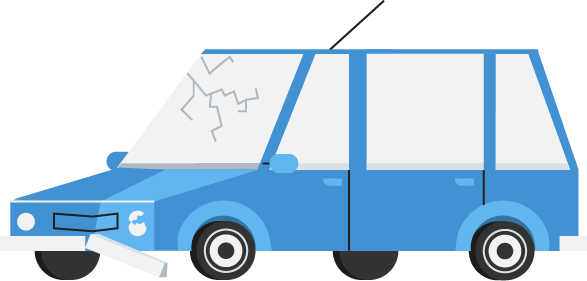



An accident occurs and you wonder if the damage suffered is covered. 3 questions help you find out.
To find out, and depending on the loss incurred, you must check whether you’re covered under your policy.
If you caused damaged to a third party, you’ll be covered since the law requires that all vehicle owners have at least $50,000 in liability coverage.
Moreover, this coverage will also protect you for damage caused to your vehicle as a result of a collision for which you aren’t at fault, and to which the Direct Compensation Agreement applies.
A number of other coverages are available to cover damage to your vehicle under other circumstances. Check the table below to see whether your policy covers you or not, depending on the coverage chosen and the loss incurred.
Damage incurred
Coverage 1
All perils
Coverage 2
Perils of Collision or Upset
Coverage 3
Perils other than Collision or Upset
Coverage 4
Specified perils
At-fault collision with another vehicle




Collision with an animal or person




Collision with an object(i.e., pole, hydrant)




Hit and run




Theft




Vandalism




Water damage: water main break or sewer back-up




Water damage: rising water




Fire/ explosion




Wind




Hail




Freezing rain




Earthquake




All individuals who drive your vehicle are covered for civil liability for damage they may cause to others, whether they’re named in the policy or not.
The damage to the vehicle itself will be covered provided you have the optional coverage required.
But be careful! Occasional “regular” drivers must be registered under the policy. For example, your teenage daughter just got her driving licence and will now be driving your vehicle. You must inform your insurer. If you don’t, you risk being only partially (or not) indemnified in case of an accident.
The answer generally is yes, since the policy covers the vehicle mentioned in the section “Policy Conditions”.
However, did you know that any other vehicles you drive, but not listed under the policy, can also be covered by the policy under certain conditions?
Here are 2 examples:
This is a vehicle you just got to replace your old vehicle, or as a second vehicle. You’ll be insured for a period of 14 days after the purchase. However, the coverage of your “old” vehicle will apply to your new vehicle. So it’s important that you contact your insurer or broker to let him know about the change, since it’s possible the coverage may not be enough for your new vehicle, if it’s a new or more recent model1.
If you aren’t able to use the vehicle registered under your policy, your insurance policy could also cover a loaner vehicle, while yours is being repaired or replaced. This applies when your vehicle cannot be used for the following reasons: breakdown, repair, maintenance, loss, destruction, sale or servicing.
1 This covers only a policyholder who has one or more vehicles insured by the same insurer.













